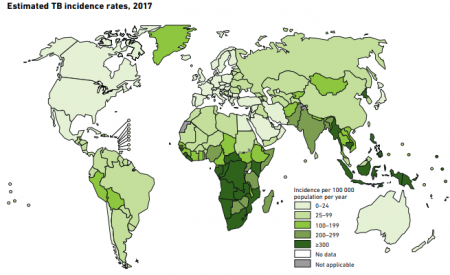September 21, 2018 – Almost one-quarter of the world’s population in 2017 was at risk to tuberculosis (TB) according to the latest World Health Organization (WHO) report. The number killed by the disease in 2017 reached 1.6 million with 10 million infected.
The good news from WHO is that the percentage of people dying from TB has declined by 43% since 2000m and that funding for prevention, diagnosis, and treatment has increased by more than double since 2006. Funding has reached $6.9 billion this year but is still considered not enough to help fight the disease according to the WHO.
Of the 10 million reported cases, 5.8 million of the infected are men, 3.2 million women, and 1.0 million children. No countries were exempt but two-thirds of the cases could be found in eight countries:
- India (27%)
- China (9%)
- Indonesia (8%)
- The Philippines (6%)
- Pakistan (5%)
- Nigeria (4%)
- Bangladesh (4%)
- South Africa (3%)
Only 3% of all reported cases were in Europe, and 3% in North America.
One of the growing problems related to TB is the emergence of a drug-resistant strain in 558,000 worldwide that don’t respond to rifampicin, the most effective treatment to date. And 82% of those not responding to drug treatment are multi-drug resistant. The countries most affected by drug-resistant strains of TB are India, China, and Russia.
Based on the distribution of TB it remains a disease of the poor. So money should overcome it. But the funding gap for diagnosis and treatment remains. Money is needed to support research into finding new drugs, purchasing and distribution of diagnostic equipment to countries most affected, and development of more effective vaccine preventatives.
In 2017 there were very few new diagnostic technologies for detecting early onset TB which is considered the best strategy for combating and eventually eliminating the disease. The same year the WHO reported 20 new drugs and 12 vaccine candidates undergoing clinical trials. A universally effective set of vaccines and a distribution and delivery network to the world’s most affected countries would put us on a path to eliminate TB, but that requires the Developed World’s capital to make this a reality. So far, not too many Western countries are bellying up to the bar with the cash and resources needed.
Big pharma, for the most part, sees little financial return in researching and developing treatment and cures for TB because the disease is found mostly in poor countries that cannot pay enough per dose to warrant the investment. Which means the not-for-profit represents the world’s best hope for finding treatment and preventatives.
Enter The Bill and Melinda Gates Foundation which is co-funding multiple drug trials through the auspices of the TB Drug Accelerator Program (TBDA). Treatment of all forms of TB including the drug-resistant versions aimed at achieving a universal drug regimen.









